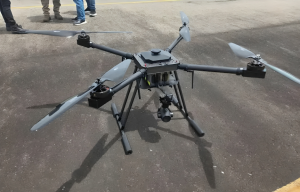Lt Gen Manoj Pande CINCAN visits ENC
- Lieutenant General Manoj Pande, AVSM, VSM; Commander-in-Chief of the Andaman & Nicobar Command (CINCAN) arrived at Visakhapatnam on 20 Jul 20 on a maiden three-day visit to Eastern Naval Command (ENC). The General is accompanied by Mrs Archana Pande, President Defence Wives Welfare Association (DWWA).
- Lt Gen Manoj Pande called on Vice Admiral Atul Kumar Jain, PVSM, AVSM VSM; Flag Officer Commanding-in-Chief ENC on 22 Jul 20 and held operational discussions. Later, he was briefed on the responsibilities of the Command and other operational activities of the Indian Navy on the Eastern Seaboard.
- Lt Gen Manoj Pande took over as the 15th Commander-in-Chief of the Andaman & Nicobar Command on 01 Jun 20. The General Officer was commissioned into the Corps of Engineers in Dec 1982 and is a graduate of Staff College in United Kingdom and attended the Higher Command Course at Army War College, Mhow and the National Security Studies Course at National Defence College, New Delhi. During his 37 years of distinguished service, the General Officer has taken an active part in Operation Vijay and Parakram.
- He commanded an Engineer Regiment along the Line of Control in Jammu & Kashmir, an Engineers Brigade as part of a Strike Corps, an Infantry Brigade along the Line of Control, a Mountain Division in the High Altitude Area of Western Ladakh and a Corps deployed along the Line of Actual Control (LAC) as also in Counter Insurgency Operations area in the North East.
- The visit assumes importance in the current geo-political scenario in which the Eastern Naval Command and the Andaman & Nicobar Command have to act in close cooperation with each other.
Indian peacekeepers’ efforts result in surrender of 39 cadre of armed group in DR Congo
- Indian peacekeepers’ efforts have led to the surrender of 39 cadre of a prominent armed group in DR Congo, the Army said on Tuesday.
- “In an historical event, efforts of Indian peacekeepers led to surrender of 39 Cadres including Second-in-Command of Mai Mai Kitete, a prominent Armed Group in North Kivu, DR Congo,” the Army said on Twitter.
- Protection of civilians is the key mandate of the mission, it said.
- India is the second largest contributor of uniformed personnel to the UN Peacekeeping.
- It currently contributes more than 5,400 military and police personnel to peacekeeping operations in Abyei, Cyprus, the DRC, Lebanon, the Middle East, Sudan, South Sudan among others.
2 Mega Watt Solar Power Plant Inaugurated at Naval Station Karanja, Uran
- Vice Admiral Ajit Kumar, PVSM, AVSM, VSM, ADC Flag Officer Commanding-in-Chief, Western Naval Command, e-inaugurated the first Two Mega Watt Capacity Solar Power Plant of the Western Naval Command on 20 Jul 2020.
- The Plant has been installed at Naval Station Karanja and is one of the largest solar plants in the region. The Solar Plant comprises of 100% indigenously developed solar panels, tracking tables and inverters. The plant is grid interconnected utilising the state of art single axis sun tracking technology with computerised monitoring & control.
- The project is a significant step by the Indian Navy towards harnessing Solar energy and use of renewable source of energy for meeting the power supply requirement of Naval Station.
India, Russia defence logistics sharing pact likely to be signed by year-end
- India and Russia are finalising a defence logistics sharing pact that can enable seamless access to each other’s military bases and support facilities, and the formal agreement is likely to be signed at the annual summit planned later this year.
- The Reciprocal Exchange of Logistics Agreement will simplify interoperability and enable support to military platforms like warships and aircraft and is of significance as Russia continues to be a leading arms supplier to India, with joint exercises also increasing in recent years.
- Sources indicated that the pact is currently being negotiated and could be signed at the next edition of the annual summit when President Vladimir Putin is on a visit here later this year. This gains significance as the pact is being planned to be signed close on the heels of the worst Sino-India stand-off along LAC in decades.
- Russia has assured steady supplies of weapons following India’s request for a variety of equipment under the emergency purchase clause, including missiles, assault rifles and key ammunition. Under the pact, warships will get access to mutual ports and exclusive economic zones to refuel and pick up supplies.
- The Indian Navy, with a significant strength of Russian origin warships, will be able to smoothly transit through for exercises or refits using the agreement while the air force will find it easier to deploy aircraft for joint exercises. Fighter aircraft will also get access as per the proposed pact. There could also be a component of deployment of troops in each other’s country up to a certain number as part of the proposed agreement.
- Following the agreement, Russians could use ports like Mumbai and Vishakhapatnam for refuelling. India, of course, could do the same when it came to Russian ports and airbases. This includes access to northern route and ports in Russian part of Arctic. India is looking at an Arctic station in near future and Russia could be a partner. Russia has also assured India access to energy resources in the vast Arctic region.
- The two sides are planning to relaunch Chennai-Vladivostok shipping route as part of their emerging partnership in the Indo-Pacific region. This can feed into defence logistics pact.
- India already has similar defence logistics sharing agreements with its largest training partner—the US. A similar agreement was also inked with France—another big ally for joint exercises—in 2018. Australia signed the pact last month while discussions are on to finalise the agreement with Japan.
Made-in-India drone to monitor Chinese aggression along the LAC
- On the backdrop of the recent standoff along the Line of Actual Control (LAC), the Indian Army has been provided special made-in-India drone by the Defence Research and Development Organisation (DRDO). The unmanned aerial vehicle (UAV), named Bharat, has been developed by Chandigarh-based laboratory of the DRDO.
- Touted by the developers to be one of the ‘world’s most agile and lightest surveillance drones’, the UAV has been developed fully indigenously by the DRDO. According to DRDO sources cited by news agency ANI, the “small yet powerful drone works autonomously at any location with great accuracy. The unibody biomimetic design with advance release technology is a lethal combination for surveillance missions”.
- Interestingly, the drone is equipped with artificial intelligence to detect friends and foes and then respond accordingly. Capable of surviving in extreme cold, the surveillance equipment has been developed keeping in mind extreme weather conditions along the LAC.
- With transgression by the Chinese troops along the LAC as the major challenge, the drone also provides real-time video transmission during the mission and can even detect humans hidden under deep forest covers. The drone has also been equipped with night vision capabilities and its stealthy design ensures that its signature remains undetected from enemy radars.
- “The Indian Army requires drones for accurate surveillance in the ongoing dispute in the Eastern Ladakh area. For this requirement, the DRDO has provided the Bharat drones to it,” a defence source was quoted as saying in the agency report.
Four sub-killer P-8I craft coming to India next year, then talks for six more
- India’s long-range anti-submarine, reconnaissance, surveillance, and electronic jamming capabilities in the Indian Ocean Region are going to get a further boost with the induction of four more P-8I multi-mission aircraft from the US next year. India has the option of buying another six from Boeing to be negotiated later in 2021, people familiar with the developments in New Delhi and Seattle said.
- The Indian Navy variant of the P-8A Poseidon – P-8I where I stands for India – is essentially designed for maritime patrol. Integrated with the Harpoon Block II air launched missiles and lightweight torpedoes, the reconnaissance craft – it can carry 129 sonobuoys to locate subs – turns into a deadly submarine killer that can also launch anti-ship missiles.
- The proposed acquisitions come against the backdrop of China’s efforts to militarise the South China Sea and expand its sea footprint.
- Beijing had already acquired a string of ports in Myanmar, Sri Lanka, Pakistan, Iran, and east Africa to not only contain the Indian Navy but also challenge the presence of US Central Command forces as well as French and British Navy.

- Beijing has 70 percent stake in Kyaukpyu port in Myanmar, which sits in the Bay of Bengal, Hambantota port in South Sri Lanka dominates the Indian Ocean, Gwadar port in Pakistan sits on the mouth of Gulf of Oman and the port of Jask in Iran is located on the edge of Persian Gulf.
- National security planners believed that the possibility of China attempting to replicate its aggressive posture along the Line of Actual Control at a time of its choosing in the Indian Ocean Region was very real, a government official said.
- India also inched closer to formalising the anti-China QUAD – Quadrilateral Security Dialogue – strategic grouping. The United States, Japan and Australia are the other members.
- In some measure, the QUAD is already a reality on the high seas due to India signing the Communications, Compatibility and Security Agreement (COMCASA) agreement in September 2019. The P-8I helped.
- The pact provided the legal framework for exchange of encrypted communication. P-8I makes this possible with ease, particularly since the aircrafts are interoperable, can communicate securely and is designed for .
- “This is a de-facto QUAD because these have interoperability with the P-8A Poseidon delivered to other countries,” said the official.
- The secure communications enables one aircraft to share real-time operational intelligence, including a Common Tactical Picture with other P-8 aircraft.
- The P-8I aircraft is designed for long-range anti-submarine warfare, anti-surface warfare, and intelligence, surveillance, and reconnaissance missions. It operates with joint and combined
- But it can be used elsewhere too. The military had relied on the reconnaissance aircraft for surveillance during the ongoing Ladakh standoff with China as well as the 2017 Doklam standoff. It has a range of about 2,200 km and flies at a maximum speed of 490 knots, or 789 km per hour.
- The negotiations for the purchase of six more P-8I aircraft are yet to begin, a government official in New Delhi said. The purchase of six P-8I was cleared by the Defence Acquisition Council in November 2019, long before the stand-off with an aggressive China along the Line of Actual Control in Ladakh.
Ukrainian Army is testing new Camel unmanned ground vehicle
- The Camel is an Unmanned Ground Vehicle (UGV) assisting dismounted troops with equipment transport and developed by the Ukrainian company Global Dynamics. The new UGV has a modular architecture and full compliance with the Army’s interoperability protocols makes the vehicle easy to upgrade, using a wide variety of missions kits, and keeps life cycle costs low.
- Operation of the platform is easy; each wheel has its own electric engine with epitrochoid harmonic drive to ensure robust torque transmission to ensure steady footing in rough terrain and on steep slopes.
- The remote control is enabled via secure radio control channel with a backup fibre-optic line. Each Camel radio system extends the reach of network coverage and allows connection of additional MESH nodes. Modular layered armour allows quick replacement of damaged parts.
- Last week, specialists from the Central Research Institute of Armaments and Military Equipment of the Armed Forces of Ukraine began a practical phase of research tests of a new tactical system.
- In particular, they checked the capabilities of the platform for movement in rough, wooded areas and in the city, as well as for the logistics of combat operations of mechanized units in the settlements.
Turkey Has Deployed ‘Surveillance Balloons’ to Patrol Syrian Border
- Turkey on Tuesday began conducting wide-scale surveillance operations at the Syrian border using balloons, produced by Turkish defense giant Aselsan.
- Deployed to border areas in the district of Reyhanli in Turkey’s southern Hatay province across from Syria’s northwestern Idlib, Karagoz is able to scan an area of eight square kilometers (3 square miles) with its mounted wide-area surveillance camera, according to the data by Aselsan.
- The seventeen-meter-long balloon can operate at altitudes of up to 500 meters (1,640 feet) and is intended to carry out surveillance missions, gather intelligence and be used for its early warning capabilities to protect military bases and critical facilities.
- It can be adapted for various tasks with different payload options, including electro-optic cameras and 360-degrees stabilized observation capabilities. Aselsan is the largest defense company of Turkey and among the top 100 defense firms in the world.
#KnowYourNavy – INS Sahyadri
- “Victory through Valour and Wisdom” is the motto of INS Sahyadri, third of the Shivalik class Stealth Frigates, built by Mazagaon Dock Limited which was commissioned into the Indian Navy on 21 July 2012.
- The 6,300 tonnes warship capable of speeds upto 30 knots is equipped with Surface to Surface & Surface to Air missiles, medium & short-range guns, Anti-Submarine rockets & an advanced Electronic Warfare & communication suite.
REVIEW QUESTIONS
- President Defence Wives Welfare Association (DWWA)
- Mrs. Asha Bhadauria
- Mrs. Archana Pande
- Mrs. Veena Naravane
- Mrs. Madhulika Rawat
ANSWER: B
- Indian peacekeepers’ efforts have led to the surrender of 39 cadre of which prominent armed group in DR Congo?
- Mai Mai Kitete
- Abyei Liberation Front
- Azania Liberation Front
- Janjaweed
ANSWER: A
- Name of the Made-in-India drone to monitor Chinese aggression along the LAC:
- Suraksha
- Netra
- Raksha
- Bharat
ANSWER: D
- Bharat drone has been developed by which city-based laboratory of the DRDO?
- Hyderabad
- Chandigarh
- New Delhi
- Bengaluru
ANSWER: B
- INS Sahyadri, the third of the Shivalik class Stealth Frigates, was built by:
- Mazagaon Dock Limited
- Cochin Shipyard Limited
- Hindustan Shipyard Limited
- Garden Reach Shipbuilders and Engineers
ANSWER: A





















